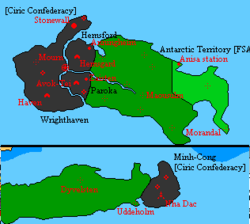Cira
| The Ciric Confederation of Wrighthaven, Hemsford, Paroka, and Minh-Cong | |||
| |||
| Motto: Praeterita Obliviscentes. Memento Posterum | |||
| Anthem: March of Progress | |||

| |||
| Map versions | |||
| Capital | Mourn | ||
| Largest city | Mourn, Stonewall, Avok-Tei | ||
| Official language(s) | Common tongue, Parokan, Minh | ||
| Official religion(s) | Cult Tecnologica | ||
| Demonym | Ciran | ||
| - Adjective | Ciric | ||
| Government | Parliamentary Republic | ||
| - Speaker | Avingar Holstadt | ||
| - Suzerain | Cedric Adsen | ||
| - Legislature | Confederate Parliament | ||
| Establishment | 1455 AN | ||
| Area | |||
| Population | 12,810,513 | ||
| Active population | 3 | ||
| Currency | Brev | ||
| Calendar | |||
| Time zone(s) | |||
| Mains electricity | |||
| Driving side | left | ||
| Track gauge | |||
| National website | |||
| National forum | |||
| National animal | Sea Raven | ||
| National food | Mac Nhen | ||
| National drink | Mead | ||
| National tree | Black Spruce | ||
| Abbreviation | CIR | ||

|
This article or section is a work in progress. The information below may be incomplete, outdated, or subject to change. |
The Homeland is… a number of things. Some of those things are such that I would consider the confederacy to be the most blessed nation on Micras; others I find to bring me to imagine vividly the downfall of all that the confederacy stands for, starting with whatever horrid sight or experience triggered the imagining itself. However, despite this, it is and will always be my Homeland. Thus, it shall always feature most prominently in my memory.—Edward Coldstone, Cira: A Legacy (1675 AN)
The Ciric Confederation of Wrighthaven, Hemsford, Paroka, and Minh-Cong, more commonly referred to as Cira, is a confederate parliamentary republic on the islands of Sypyr and Hypernostria which is comprised of the constituent governorates of Wrighthaven, Hemsford, Paroka, and Minh-Cong. The confederacy, which was united under one flag in 1455 AN, is governed in a system that is thought to be based off of an ancient tribal council system, but has evolved to the modern confederate parliamentary system. The confederacy places high value on scientific progress due to the prevalence of the worship of machinery in the area, which originated with the discovery of mysterious documents in the city of Anningheim in 1222.
Culture
The culture of the confederacy is often the subject of debate amongst Ciric scholars and anthropologists, since the path of most traditions and points of culture are difficult to trace back to any singular tradition of the three constituent tribes which founded the confederacy, due to the Ciric practice of dispensing with unnecessary records. This idea is considered one of the most important embodiments of the national motto: Forget the Past. Remember the Future. This is most often interpreted to be best observed by the extirpation of needless historical records which do not hold relevance. Thus, though the past is not necessarily scorned, it is also not placed upon a pedestal to be misconstrued to the point of myths. Individual names are not considered important information to preserve, and are thus discarded and often lost to the annals of history. Information, however, such as that which leads to the discovery of an important invention, as well as the general course of events, is preserved officially. It is not illegal to preserve pieces of information which are not accepted to be important to the nation, however this is not common because of the general stigma about past specificities. Much of the confederacy's culture today was carried through the ages through word of mouth and other such methods of transmission outside of official vectors.
Most of the larger aspects of the confederacy's culture originate with the 1222 discovery of the Anningheim Documents, which provide a framework not only for Ciric culture but also for the most common Ciric religion, that being the Cult Tecnologica. The specifics of these documents is the most read information in the confederacy, with the documents containing both blueprints, schematics, and formulae which lead to the early scientific leap taken by the confederate constituent tribes in the thirteenth century, but also the philosophies of the writers of the documents, which provide the basis for the Cult Tecnologica. These philosophies lead to a common feeling throughout the confederacy that progress is the most important part of society. Scientists, engineers, and doctors are held in the highest regard throughout the confederacy, solidifying the strata that form the basis of the informal caste system, with administrators at the top, followed by the scientific community, the military, and finally the civilian base. Unlike other caste systems, however, mobility is possible, although not always encouraged. The proper allocation of careers is a high priority in the confederacy, and though an individual's caste occasionally determines the amount of respect given to them, it is still considered important for the confederacy to maintain a skilled base of labourers and managers of services to hold up the higher castes, and thus an individual is considered to be a responsible and respectable confederate citizen if they maintain a service or industrial based career for the good of the whole confederacy.

